1993 CHEVROLET CAVALIER service
[x] Cancel search: servicePage 235 of 308
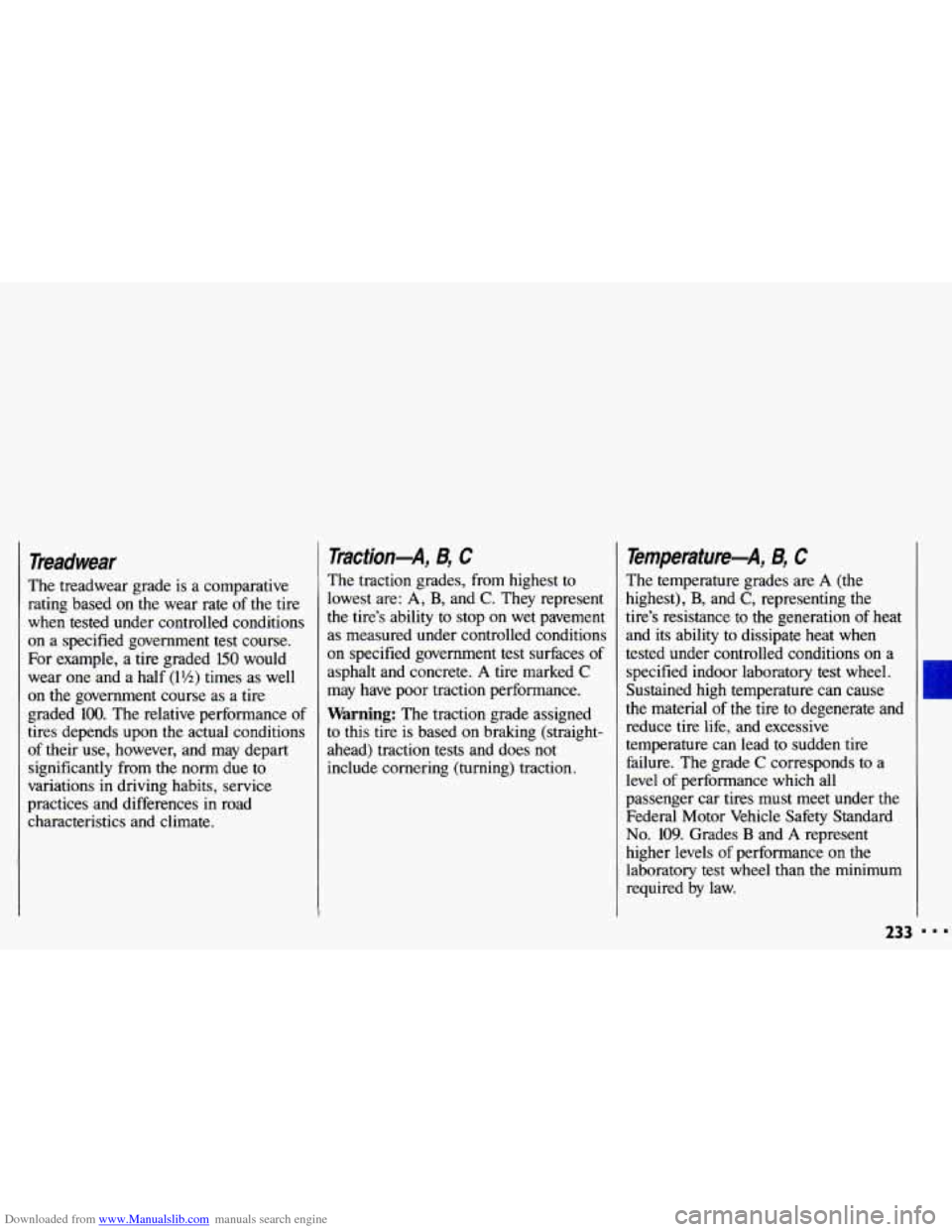
Downloaded from www.Manualslib.com manuals search engine Treadwear
The treadwear grade is a comparative
rating based on the wear rate of the tire
when tested under controlled conditions
on a specified government test course.
For example, a tire graded 150 would
wear one and a half
(1%) times as well
on the government course as a tire
graded
100. The relative performance of
tires depends upon the actual conditions
of their use, however, and may depart
significantly from the norm due to
variations in driving habits, service
practices and differences in road
characteristics and climate.
Traction-A, B, C
The traction grades, from highest to
lowest are:
A, B, and C. They represent
the tire’s ability
to stop on wet pavement
as measured under controlled conditions
on specified government test surfaces of
asphalt and concrete.
A tire marked C
may have poor traction performance.
Warning: The traction grade assigned
to this tire
is based on braking (straight-
ahead) traction tests and does
not
include cornering (turning) traction.
Temperature-A, B, C
The temperature grades are A (the
highest),
B, and C, representing the
tire’s resistance to the generation of heat
and its ability to dissipate heat when
tested under controlled conditions on a
specified indoor laboratory test wheel.
Sustained high temperature can cause
the material of the tire to degenerate and
reduce tire life, and excessive
temperature can lead
to sudden tire
failure. The grade
C corresponds to a
level of performance which all
passenger car tires must meet under the
Federal Motor Vehicle Safety Standard
No. 109. Grades B and A represent
higher levels of performance
on the
laboratory test wheel than the minimum
required
by law.
233
Page 236 of 308
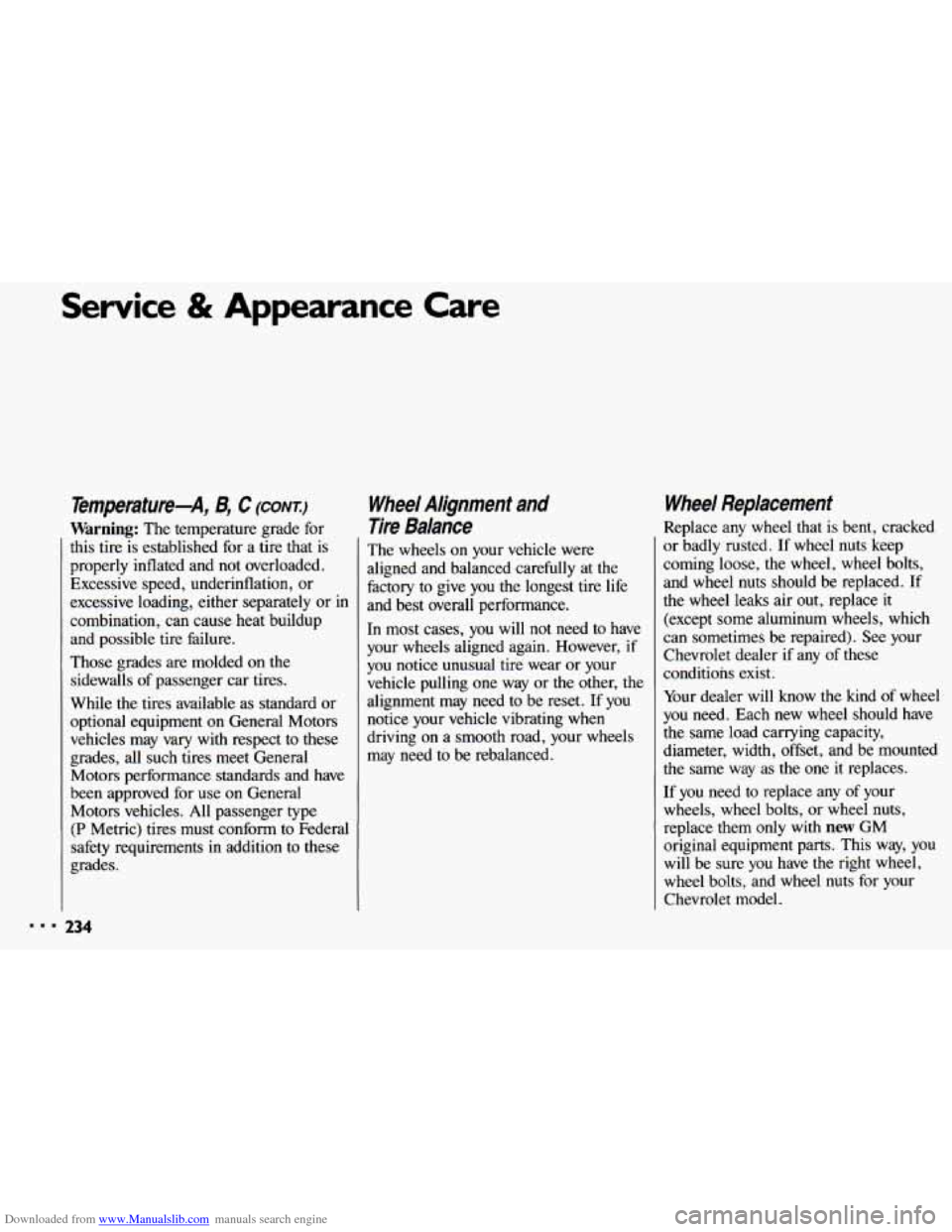
Downloaded from www.Manualslib.com manuals search engine Service & Appearance Care
Temperature-A, 8, C ~NTJ
Warning: The temperature grade for
this tire is established for a tire that is
properly inflated and not overloaded.
Excessive speed, underinflation,
or
excessive loading, either separately or in
combination, can cause heat buildup
and possible tire failure.
Those grades are molded on the
sidewalls of passenger car tires.
While
the tires available as standard or
optional equipment on General Motors
vehicles may vary
with respect to these
grades, all such tires meet General
Motors performance standards and have
been approved for use on General Motors vehicles.
All passenger type
(P Metric) tires must conform to Federal
safety requirements in addition to these
grades.
234
Wheel Alignment and
Tire Balance
The wheels on your vehicle were
aligned and balanced carefully at the
factory to give you the longest tire life
and best overall performance.
In most cases, you
will not need to have
your wheels aligned again. However,
if
you notice unusual tire wear or your
vehicle pulling one way or the other, the
alignment may need to be reset. If you
notice your vehicle vibrating when
driving on a smooth road, your wheels
may need to be rebalanced.
Wheel Replacement
Replace any wheel that is bent, cracked
or badly rusted. If wheel nuts keep
coming loose, the wheel, wheel bolts,
and wheel nuts should be replaced. If
the wheel leaks air out, replace
it
(except some aluminum wheels, which
can sometimes be repaired). See your
Chevrolet dealer if any of these
conditions exist.
Your dealer
will know the kind of wheel
you need. Each new wheel should have
the same load carrying capacity,
diameter, width, offset, and be mounted
the same way as the one
it replaces.
If you need to replace any of your
wheels, wheel bolts, or wheel nuts,
replace them only
with new GM
original equipment parts. This way, you
will be sure you have the right wheel,
wheel bolts, and wheel nuts for your
Chevrolet model.
Page 238 of 308
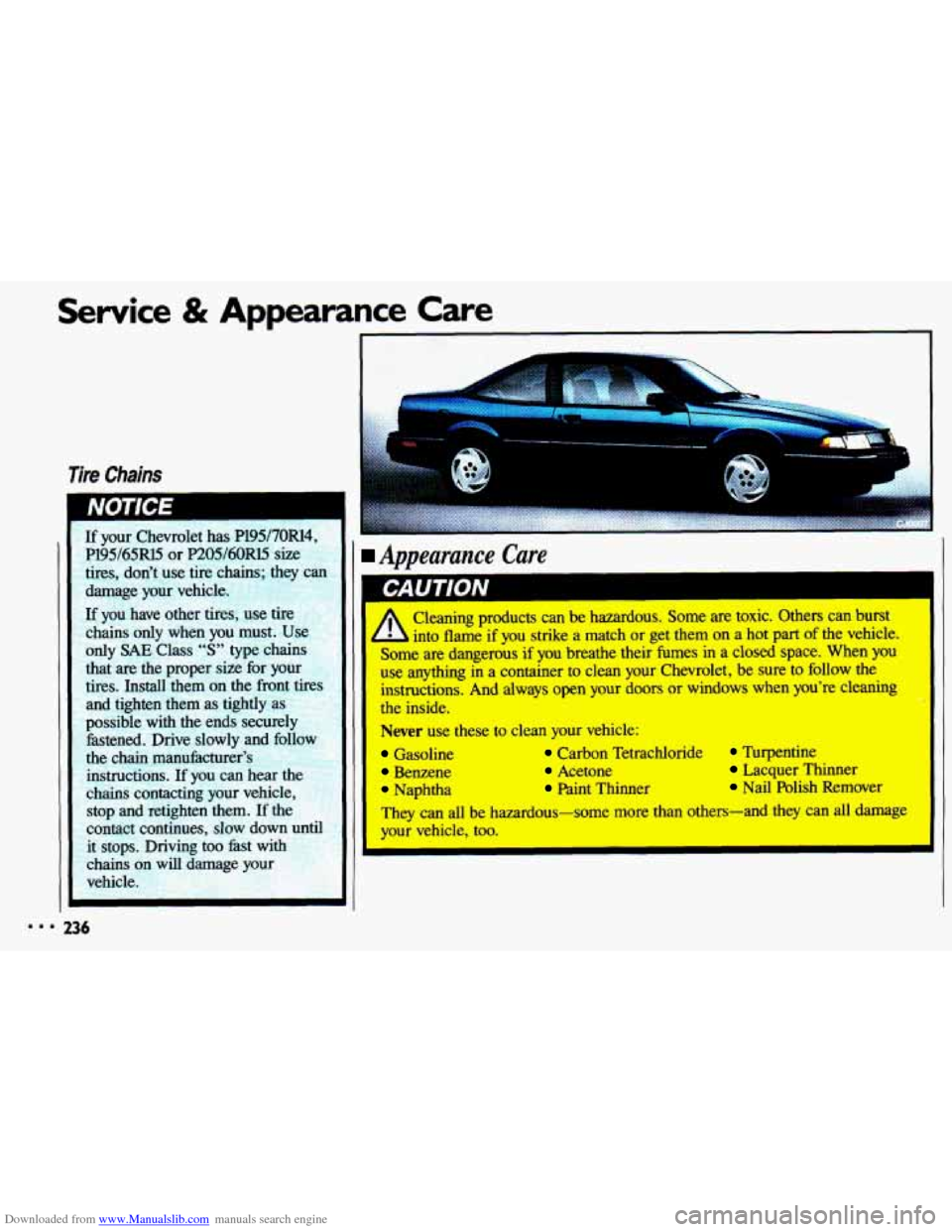
Downloaded from www.Manualslib.com manuals search engine Service & Appearance Care
Tire Chains
Appearance Care
A
Cleaning products can be hazardous. Some are toxic. Others can burst
into flame if you strike
a match or get them on a hot part of the vehicle.
Some are dangerous
if you breathe their fumes in a closed space. When you
use anything in a container to clean your Chevrolet, be sure to follow the
instructions. And always open your doors or windows when you’re cleaning
the inside.
Never use these to clean your vehicle:
Gasoline Carbon Tetrachloride Turpentine I
Benzene
Naphtha Paint Thinner Nail Polish Remover
They can all be hazardous-some more than others-and they can
all damage
your vehicle, too.
I I
Acetone Lacquer Thinner
Page 240 of 308
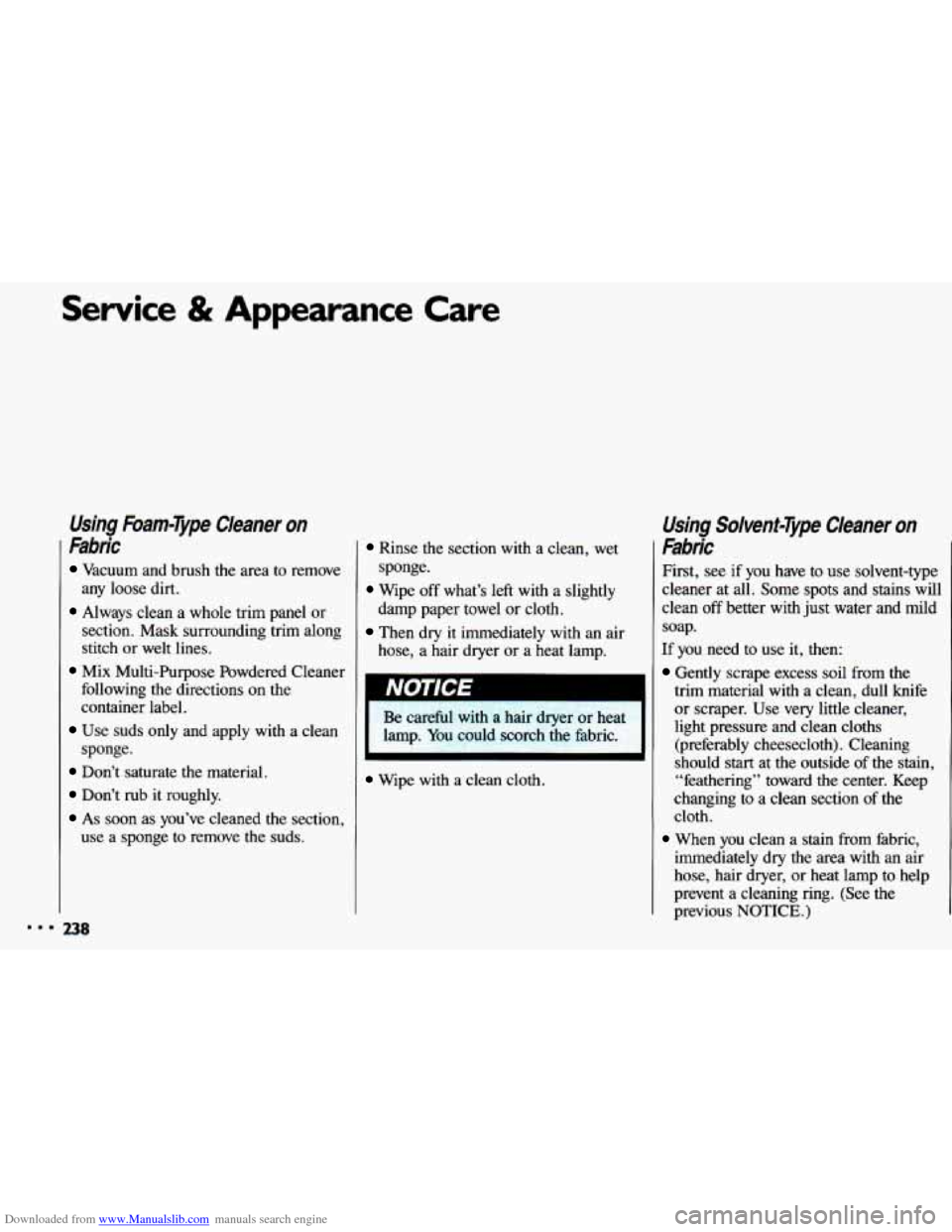
Downloaded from www.Manualslib.com manuals search engine Service & Appearance Care
Using &am-Type Cleaner on
Fabric
Vacuum and brush the area to remove
any loose dirt.
Always clean a whole trim panel or
section. Mask surrounding trim along
stitch or welt lines.
Mix Multi-Purpose Powdered Cleaner
following the directions on the
container label.
Use suds only and apply with a clean
Don’t saturate the material.
Don’t rub it roughly.
As soon as you’ve cleaned the section,
sponge.
use a sponge to remove the suds.
Rinse the section with a clean, wet
sponge.
Wipe off what’s left with a slightly
damp paper towel or cloth.
Then dry it immediately with an air
hose,
a hair dryer or a heat lamp.
I
Be careful with a hair dryer or heat
lamp. You
could scorch the fabric. I
Wipe with a clean cloth.
Using Solvent-Type Cleaner on
Fabric
First, see if you have to use solvent-type
cleaner at all. Some spots and stains will
clean
off better with just water and mild
soap.
If you need to use it, then:
Gently scrape excess soil from the
trim material with a clean, dull knife
or scraper. Use very little cleaner,
light pressure and clean cloths (preferably cheesecloth). Cleaning
should start at the outside of the stain,
“feathering” toward the center. Keep
changing to a clean section
of the
cloth.
When you clean a stain from fabric,
immediately dry the area with an air
hose, hair dryer, or heat lamp to help
prevent a cleaning ring. (See the
previous
NOTICE.)
Page 242 of 308
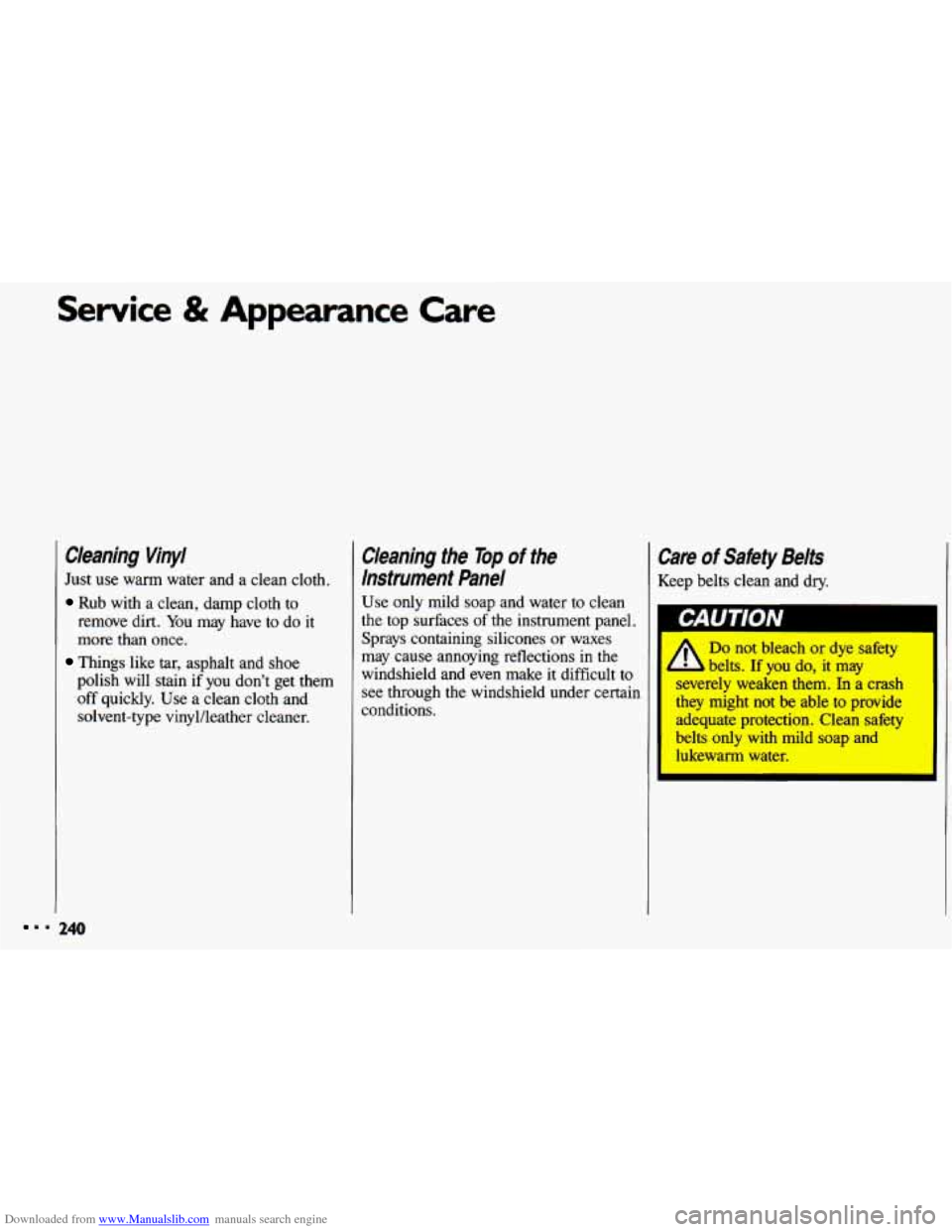
Downloaded from www.Manualslib.com manuals search engine Service & Appearance Care
Cleaning Vinyl
Just use warm water and a clean cloth.
Rub with a clean, damp cloth to
remove dirt.
You may have to do it
more than once.
polish will stain if you don’t get them
off quickly. Use a clean cloth and
solvent-type vinyl/leather cleaner.
Things like tar, asphalt and shoe
Cleaning the Top of the
instrument Panel
Use only mild soap and water to clean
the top surfaces of the instrument panel.
Sprays containing silicones or waxes
may cause annoying reflections
in the
windshield and even make it difficult to
see through the windshield under certain
conditions.
Care of Safety Belts
Keep belts clean and dry.
CAUTION
Do not bleach or dye s&ty
severely weaken them. h a crash
they might not be able to provide
adequate protection. Clean safety
belts only with mild soap and
lukewarm water.
- belts. If you do, it may
. . 240
Page 244 of 308
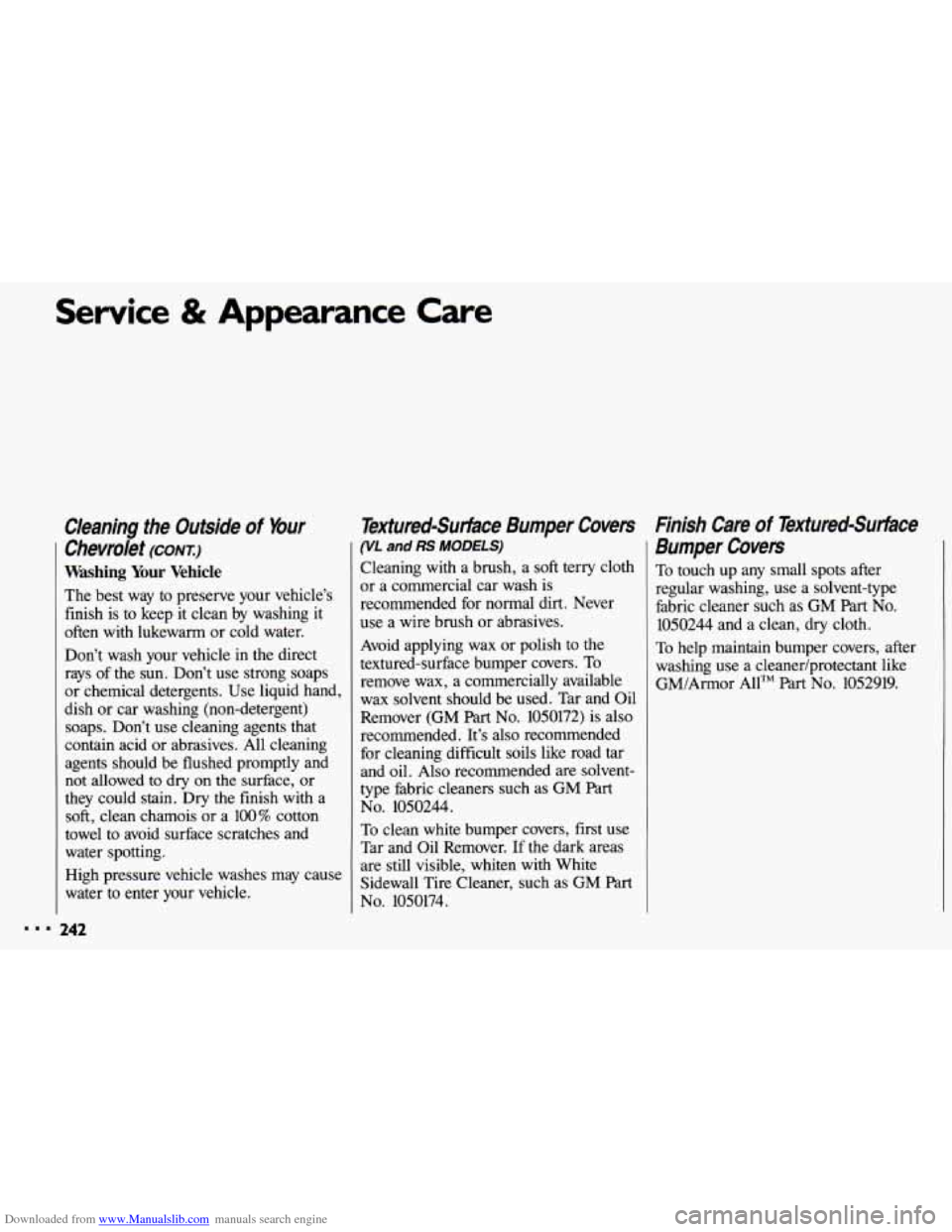
Downloaded from www.Manualslib.com manuals search engine ...
Service & Appearance Care
Cleaning the Outside of Your
Chevrolet (CONT)
Washing Your Vehicle
The best way to preserve your vehicle’s
finish is to keep it clean by washing it
often with lukewarm or cold water.
Don’t wash your vehicle in the direct
rays of the sun. Don’t use strong soaps
or chemical detergents. Use liquid hand,
dish
or car washing (non-detergent)
soaps. Don’t use cleaning agents that
contain acid or abrasives. All cleaning
agents should be flushed promptly and not allowed to dry on the surface, or
they could stain.
Dry the finish with a
soft, clean chamois or a 100% cotton
towel to avoid surface scratches and water spotting.
High pressure vehicle washes may cause
water
to enter your vehicle.
242
Textured-Surface Bumper Covers
(VL and RS MODELS)
Cleaning with a brush, a soft terry cloth
or a commercial car wash is
recommended for normal dirt. Never
use a wire brush or abrasives.
Avoid applying wax
or polish to the
textured-surface bumper covers. To
remove wax, a commercially available
wax solvent should be used. Tar and Oil
Remover (GM Part
No. 1050172) is also
recommended. It’s also recommended
for cleaning difficult soils like road tar
and oil. Also recommended are solvent-
type fabric cleaners such as GM Part
No. 1050244.
To clean white bumper covers, first use
Tar and Oil Remover. If the dark areas
are still visible, whiten with White
Sidewall Tire Cleaner, such as GM Part
No. 1050174.
Finish Care of Textured-Surface
Bumper Covers
To touch up any small spots after
regular washing, use a solvent-type
fabric cleaner such as GM Part No.
1050244 and a clean, dry cloth.
To help maintain bumper covers, after
washing use a cleaner/protectant like
GM/Armor AllTM Part No. 1052919.
Page 246 of 308
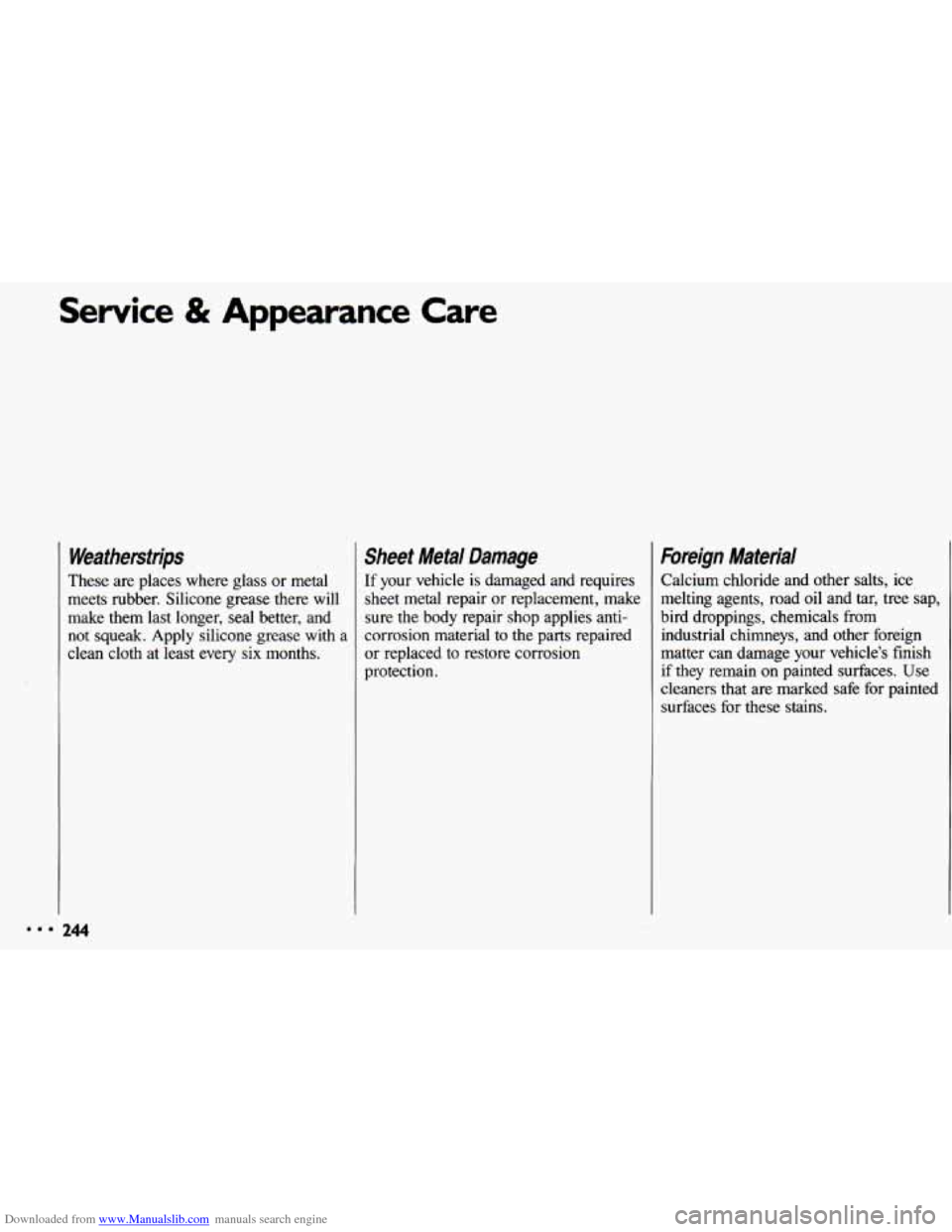
Downloaded from www.Manualslib.com manuals search engine DDD
Service & Appearance Care
Weatherstrips
These are places where glass or metal
meets rubber. Silicone grease there will
make them last longer, seal better, and
not squeak. Apply silicone grease with a
clean cloth at least every six months.
244
Sheet Metal Damage
If your vehicle is damaged and requires
sheet metal repair or replacement, make
sure the body repair
shop applies anti-
corrosion material to the parts repaired
or replaced to restore corrosion
protection.
breign Material
Calcium chloride and other salts, ice
melting agents, road oil and tar, tree sap,
bird droppings, chemicals from industrial chimneys, and other foreign
matter can damage your vehicle’s finish
if they remain
on painted surfaces. Use
cleaners that are marked safe for painted
surfaces for these stains.
Page 247 of 308
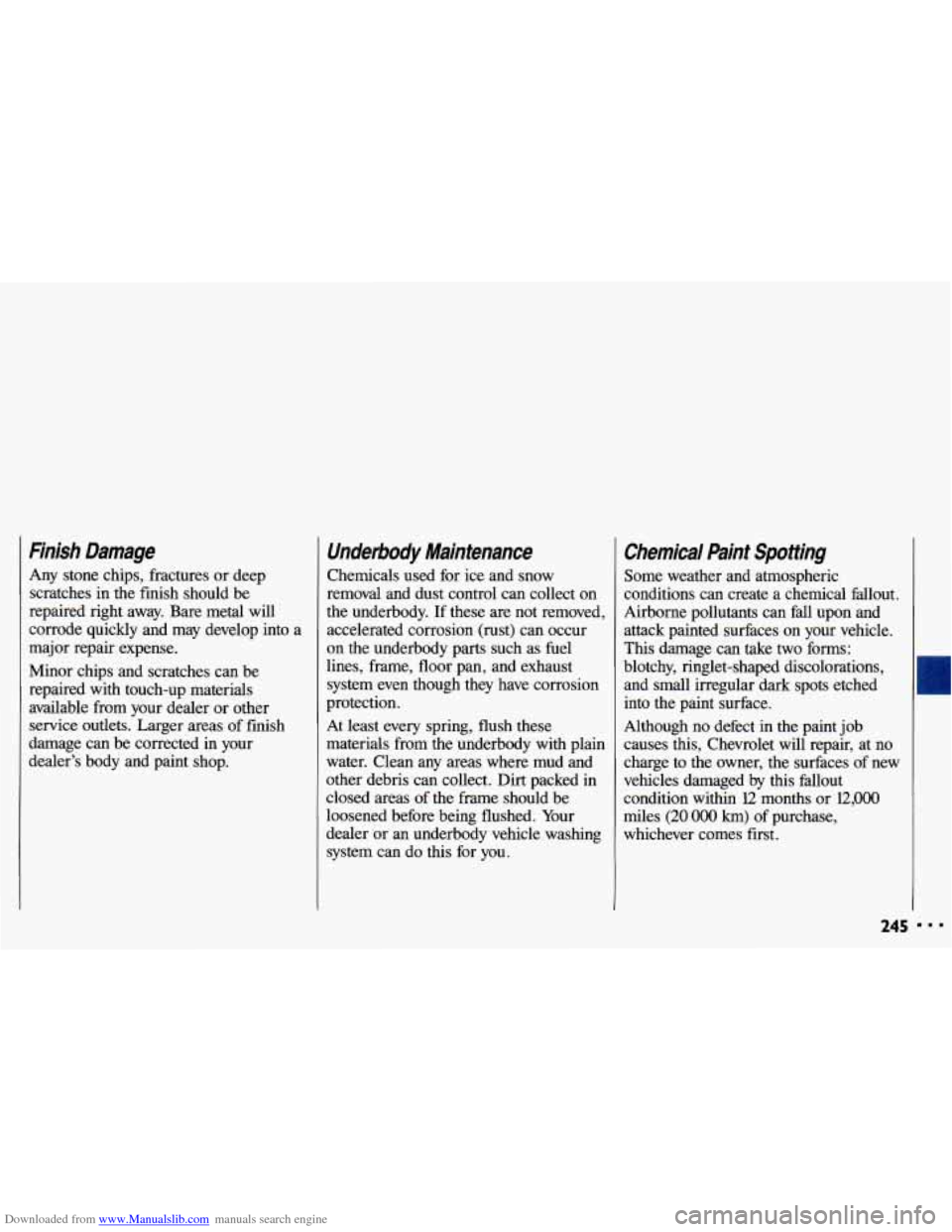
Downloaded from www.Manualslib.com manuals search engine Finish Damage
Any stone chips, fractures or deep
scratches
in the finish should be
repaired right away. Bare metal will
corrode quickly and may develop into a
major repair expense.
Minor chips and scratches can be
repaired with touch-up materials
available from your dealer or other
service outlets. Larger areas of finish
damage can be corrected in your
dealer’s body and paint shop.
Underbody Maintenance
Chemicals used for ice and snow
removal and dust control can collect on
the underbody. If these are not removed,
accelerated corrosion (rust) can occur
on the underbody parts such as fuel
lines, frame, floor pan, and exhaust
system even though they have corrosion
protection.
At least every spring, flush these
materials from the underbody with plain
water. Clean any areas where mud and
other debris can collect. Dirt packed in
closed areas
of the frame should be
loosened before being flushed. Your
dealer or an underbody vehicle washing
system can do this for you.
Chemical Paint Spotting
Some weather and atmospheric
conditions can create a chemical fallout.
Airborne pollutants can fall upon and
attack painted surfaces on your vehicle.
This damage can take two forms:
blotchy, ringlet-shaped discolorations, and small irregular dark spots etched
into the paint surface.
Although no defect in the paint job
causes this, Chevrolet will repair, at no
charge to the owner, the surfaces of new
vehicles damaged by this fallout
condition within
l2 months or l2,OOO
miles (20 000 km) of purchase,
whichever comes first.
245 I